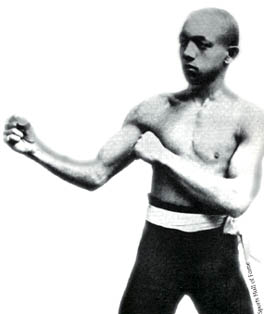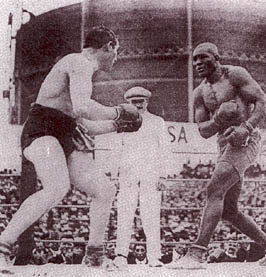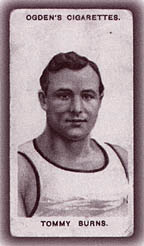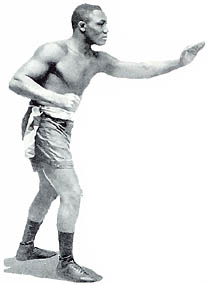RING CHAMPIONS
Dixon, Burns, McLarnin & Langford
To celebrate Mardi Gras week in September 1892, the New
Orleans Olympic Club arranged a boxing extravaganza: champion John L. Sullivan would meet
James J. Corbett for the world heavyweight crown. Two other title fights would take place
that same week, one featuring the first black man to hold a world title. His name was
George ("Little Chocolate") Dixon from Halifax, Nova Scotia.

|
The first black boxer to win a
world title in any division, George Dizon, according to Nat Fleischer, was the
"greatest little fighter the black race has ever produced." Except for a brief
spell, the Canadian was the world champion between 1890 and 1900 in either the
bantamweight or the featherweight divisions
[Canadian Sports Hall of Fame] |
Dixon had won the bantamweight crown in London, England, in
1890, when at age 20 he knocked out Nunc Wallace, considered unbeatable at that time. He
added the featherweight title at Troy, New York, a year later when he stopped Cal McCarthy
in 22 rounds, but he was not universally accepted as champion of that division until he
beat Fred Johnson of England in June 1892. In New Orleans his title was on the line in the
match against Frank Skelly. He won and went on to defend the title a total of 23 times over
the next three years, an achievement that ranked George Dixon as one of the greatest
featherweight champions in the history of boxing.
While Dixon was boxing his way into history, another Canadian was on his way up to a
championship. His name was Noah Brusso. Of Italian descent, he was born in 1881 in
Hanover, Ontario. Starting as a welterweight fighting under the name of Tommy Burns, he
gradually built up his body over 38 fights to clinch the heavyweight title in 1906. This
occurred when the champion, Jim Jeffries, retired and selected Marvin Hart to replace him.
Bums beat Hart seven months later in 20 rounds. A chunky, 175 pounder of 5 feet 7 inches,
Bums was the shortest title holder in the history of the division. He also fought the
shortest title defence in the history of heavyweights up to that time when he knocked out
the Irish champion in 128 minutes of the first round. Described by one writer as gutsy and
aggressive, Bums was also one of the few boxers of any era who fought without a manager.


|
| Agreeing to a showdown with the
notorious Jack Johnson in Sydney, Astralia, 1908, Tommy Burns lost his title to Johnson,
the first black man ever to win the heavyweight championship of the world [Courtsey, Janet
Butchart] [C.J. Humber Collection] |
Although Bums won a championship and defended in 1909. he
was not the choice of Canadian Press for the "Boxer of the Half Century." That
honour went to Sam Langford, a native of Weymouth Falls, Nova Scotia, who began boxing
professionally as a lightweight and ended his career ranked as one of the best heavyweight
boxers in history. He was one of the few men to knock down the infamous Johnson as he did
in 1906, before Johnson won the title from Bums. Langford never got a second chance to
meet Johnson as champion because, it was argued, people would not come to see two black
men fight in the same ring at the same time.
Although born in Belfast, Ireland, in 1907 Jimmy McLarnin was the third world champion
identified as a Canadian. His family farmed at Mortlack, Saskatchewan, for six years
before moving on to Vancouver when Jimmy was nine years old. Dubbed "Baby Face,"
he was one of the most colourful and popular fighters of the mid-thirties, winning the
welterweight crown by knocking out Young Corbett III in the first round and then losing,
winning, and losing the title to Barney Ross in three 15-round battles over a one-year
period. Describing the final bout on May 28, 1935, one sportswriter wrote: "For 15
rounds at the Polo Grounds last night McLarnin, once again the babyfaced bomber, threw
every punch he had, executed every wile learned in years of fighting the best of 'em. But
it wasn't enough." He described how the scrappy McLarnin won the 15th and final
round: "with as gallant a last stand as any champion ever made. For full three
minutes he stood toe to toe, chin to chin, with Barney, and fired his last round of ammunition. He
didn't save a bullet. When the bell rang, he didn't have a left hook or an uppercut or a
right cross left in his body. If he had to lose - and he did - he certainly chose the
magnificent way. He went down swinging."
 |
Vancouverite Jimmy McLaurin,
welterweight champion of the world in 1933, lost and regained the title in 1934 with the
renowned Barney Ross. He was one of the finest athletes ever produced in this country
[C.J. Humber Collection] |
The fortunes of these boxers are as varied as their weights and their careers. Dixon,
described as a clever boxer and a devastating hitter for his size, boxed in both the USA
and Britain, defending his title 23 times before being defeated by Terry McGovern in 1900.
Despite excellent earnings from his ring career - his purse was $ 7,500 when he won the
featherweight championship and he made another $5,000 on a side bet - Dixon kept fighting
after losing the championship in order to cater to his weaknesses for gambling, alcohol,
and the good life. In the next five years he won only 11 bouts and died in 1909 in New
York City of consumption complicated by his heavy drinking.
Tommy Bums was one of the first heavyweight champions to travel extensively to meet
challengers. After winning the title in 1906 in Los Angeles and defending it four times in
California, he went to England, Ireland, and France for title matches before beating Bill
Squires for the third time in Sydney, Australia, in August 1908. Two weeks later he
defended his title in Melbourne and then agreed to fight lack Johnson in Sydney on Boxing
Day, 1908.
Johnson, a huge black man from Galveston, Texas, knocked Bums down with his first punch
and toyed with the Canadian for 14 rounds before police stopped the fight. According to
boxing historian John Gromach it was a grudge match from the start filmed for silent
pictures, "but no radio or talking picture could have used it since the contestants
hurled insults and profanity at each other during the entire fight with even more abandon
than their fists."

|
Born in Weymouth, Nova Scotia,
Sam Langford was the most feared fighter in the ring even though he fought constantly out
of his division. Regarded by some authorities as the greatest boxer who ever lived, even
Jack Johnson, after he won the heavyweight title from Tommy Burns, feared Langford,
"the most talented fighter never to win a world championship" [C.J. Humber
Collection] |
Burns, who was one of the first to fight for big purses (he
got $30,000, Johnson got $5,000), fought ten more times in Canada and the United States,
then gave up boxing to become a successful owner of a pub in London and a speakeasy in New
York during the roaring twenties. Eventually settling in Bremerton, Washington State, he
became known in the 1930s as a soft-spoken, likable, stately man who had "the respect
of everyone," at least according to one local resident. Stricken in 1935 with an
illness that nearly killed him, Bums turned to religion, was ordained a minister at his
home city of Coalinga, California, in 1948, and served as an evangelist throughout the
northwestern United States and Canada until he died of a heart attack while visiting
Vancouver in 1955.
Sam Langford, known as the "Boston Tar Baby," challenged Johnson for a title
fight repeatedly but was refused. By the time Jess Willard beat Johnson in 1915, Johnson's
reputation as a womanizer - especially white women - angered the American public so badly
that for the next two decades there was no interest in seeing another black man win the
heavyweight title. As a result, Langford had to settle for the heavyweight titles of
Wales, England, Spain, and Mexico, the latter fought in 1923 when he was 37 years old and
considered legally blind. He wound up angry, penniless, and stone blind sitting most of
the time on the front stoop of an old tenement in Harlem. He died penniless in 1956 in
Cambridge, Massachusetts, at age 70.
McLarnin was 12 years old and a Vancouver newsboy when he met 47-year-old Charles
("Pop") Foster. This meeting led to one of the most remarkable partnerships and
legendary friendships of the fight world. "Pop" trained and managed Jimmy from
then on and, with his parents' permission, Jimmy, at age 16, went with "Pop" to
San Francisco in 1924 to fight as a 4 foot 10 inch 108 pound flyweight. He won ten bouts
in four months and quickly became a mainliner. In 1925, he defeated the former flyweight
champion, Pancho Villa, the first of 13 ex-champions, champions or future champions he was
to fight in 77 bouts.
After the Villa fight he bought a house in Vancouver for his parents and eight of their
twelve children still living at home. Between his 17th and 18th birthdays he grew six
inches, lost a few fights, and was considered washed up at 19. In October 1927, however,
he fought Kid Kaplan, former world featherweight champion with 11 fights as a lightweight.
Although Kaplan broke Jimmy's jaw, McLarnin won by a knockout in round eight to
reestablish his career.
In 1935 after losing the championship to Ross in their third match, McLarnin split
decisions with Tony Conzoneri and defeated Lou Ambers in 1936, but his heart was no longer
in the ring. He had married his childhood sweetheart from Vancouver and agreed with
"Pop" who told him, "There are only two reasons to fight ... because you
like it and you stopped liking it a long time ago ... and the other's for money and you
know you don't need money."
Jimmy didn't. He had saved most of the more than a half million dollars he had made in the
ring, went into business in a Los Angeles suburb, and took up golf, playing in various
tournaments and with celebrities such as Bob Hope, Fred Astaire, and Joe Louis. When
"Pop," known as his pennypinching friend and manager, died at age 83, Jimmy was
left his entire fortune as well. It amounted to $240,000.





